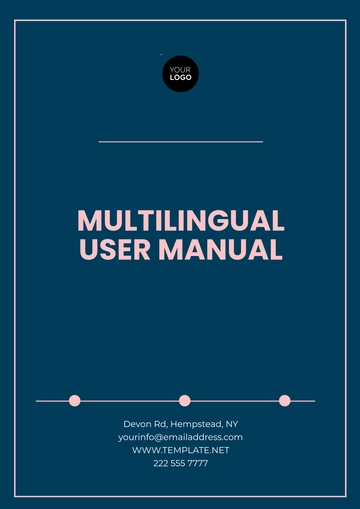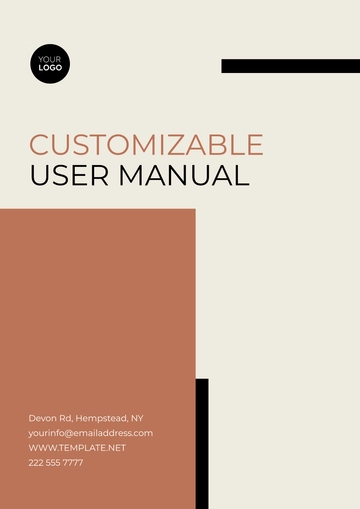Free Social Media Content Quality Advertising Manual

INTRODUCTION
Purpose of the Manual
This manual is meticulously crafted to be your compass in navigating the intricate realm of creating impactful and high-quality content for social media advertising. It provides a comprehensive approach, delving into key facets such as audience comprehension, strategic content development, mobile optimization, and the critical realm of legal compliance.
Target Audience
Whether you're a seasoned marketing professional, a creative content professional, or anyone immersed in the curating social media advertising campaigns, this manual is your go-to resource. Tailored to meet the needs of individuals across diverse roles, it offers insights and techniques that transcend industry boundaries, empowering you to curate campaigns that resonate with your audience.
Overview of Social Media Advertising
In the ever-evolving landscape of digital marketing, social media advertising stands as a dynamic force. It entails the creation and deployment of paid promotional content across various social media platforms with the primary goal of captivating and engaging a specific target audience. The efficacy of these endeavors is gauged through key metrics such as clicks, impressions, and conversions, representing not just visibility but tangible user interactions that propel your brand forward in the digital sphere.
1. Understanding Your Audience
Understanding your audience is the cornerstone of effective social media advertising. By delving into the intricacies of who your audience is and how they behave, you can tailor your content for maximum impact.
1.1. Identifying Target Demographics
Before creating the content, identify the demographic makeup of your audience. Identify key factors such as age, gender, location, and interests. This wealth of information serves as the foundation for content customization, ensuring that your message resonates profoundly with the specific characteristics of your target audience.
Armed with demographic insights, craft content that speaks directly to the unique attributes of your audience. Whether it's tailoring language, imagery, or overall tone, this customization enhances engagement by making your content more relatable and appealing.
1.2. Analyzing User Behavior
Understanding when your audience is most active is a strategic advantage in the realm of social media advertising.
1.2.1. Platform-Specific Behavior Patterns
Different social media platforms witness varying user activity throughout the day. Analyze user behavior on each platform to discern peak activity periods. This insight allows for precise scheduling of ads, ensuring optimal visibility and engagement.
1.2.2. Real-Time Adaptation
User behavior is dynamic, influenced by factors such as time zone differences and cultural trends. Regularly analyze real-time data to adapt your ad schedule, maximizing visibility during periods of heightened user activity.
1.3. Creating Personas for Targeted Campaigns
1.3.1. The Art of Persona Development
Crafting fictional personas is a powerful tool in shaping targeted campaigns. These personas represent archetypal individuals who embody the characteristics of your ideal customers. Dive into the psyche of your audience and create personas that encapsulate their aspirations, challenges, and preferences.
1.3.2. Tailoring Content to Personas
Once personas are established, tailor your content to align seamlessly with these fictional characters. From the language used to the visual elements employed, the goal is to create content that emotionally resonates with the identified personas, fostering a deeper connection and driving higher engagement.
2. Content Strategy
Crafting a robust content strategy is the linchpin of a successful social media advertising campaign. From defining objectives to establishing a brand voice, each element plays a pivotal role in shaping an impactful narrative.
2.1. Defining Clear Objectives
2.1.1 The Significance of Clear Goals
Begin your content strategy journey by clearly defining the objectives of your campaign. Whether the aim is to bolster brand awareness, drive lead generation, or promote a specific product, crystallize these goals. Clear objectives not only provide a roadmap for your campaign but also serve as the benchmark for assessing success.
2.1.2 Guiding Content Creation and Measurement
Once objectives are defined, let them be the guiding force behind every piece of content created. Align the messaging, visuals, and calls-to-action with these objectives to ensure a cohesive and purposeful campaign. Additionally, use defined objectives as metrics for measuring success, allowing for informed adjustments throughout the campaign's lifecycle.
2.2. Crafting Compelling Messaging
2.2.1. The Power of Concise Communication
Crafting messages that resonate with your audience requires a delicate balance of brevity and impact. Create concise and memorable messages that succinctly convey your brand's value proposition. In a world inundated with information, a message that stands out for its clarity and impact is more likely to capture attention.
2.2.2. Language that Resonates
Understand the nuances of your audience's language and preferences. Tailor your messaging to resonate emotionally with your audience. Whether it's humor, inspiration, or a practical approach, the language used should forge a connection and leave a lasting impression.
2.3. Establishing Brand Voice and Tone
2.3.1. Consistency as a Cornerstone
Maintaining a consistent brand voice across all communication channels is paramount. Your audience should instantly recognize your brand by the way it communicates. Consistency fosters trust and reliability, essential components in building a strong brand presence.
2.3.2. Defining a Distinctive Voice and Tone
Establish a distinctive brand voice and tone that aligns seamlessly with your brand identity. Whether it's casual and conversational or formal and authoritative, define the nuances that set your brand apart. Consistently applying this voice and tone across all content ensures a cohesive and recognizable brand image.
3. Visual Elements
Visuals possess the unique ability to convey complex messages swiftly and leave a lasting impression. This section provides insights into maximizing the impact of visual content through high-quality images and engaging videos that resonate with your brand identity.
3.1. Importance of Visual Content
The human brain processes visuals much faster than text, making the inclusion of compelling images and videos a crucial aspect of any successful social media campaign. Visual content not only captures attention but also establishes a deeper connection with the audience, evoking emotions and enhancing brand recall. To harness this power, ensure that your visual elements align seamlessly with your brand narrative and overall messaging strategy.
3.2. Guidelines for High-Quality Images
Creating visually stunning images requires a meticulous approach. Images should be clear, high-resolution, and formatted appropriately for each social media platform. Each platform has its own specifications for image dimensions, so tailor your visuals accordingly to maintain quality and consistency. Avoid cluttering images with excessive text overlays, as they can dilute the impact and hinder reach. Opt for concise, well-placed text that complements the visual rather than competing with it.
Tips for High-Quality Images:
Prioritize clarity and resolution.
Adhere to platform-specific image dimensions.
Maintain brand consistency in color schemes and themes.
Test different image variations to identify what resonates best with your audience.
3.3 Incorporating Videos for Engagement
Video content stands out as a dynamic and highly engaging medium in the social media landscape. Short, impactful videos can convey messages more comprehensively than static images. To maximize engagement, craft videos that not only showcase your products or services but also tell a compelling story. Consider the following aspects when incorporating videos into your social media
strategy:
Storytelling: Develop a narrative that aligns with your brand's values and resonates with your target audience.
Length: Keep videos concise. Aim for a duration that maintains viewer interest and fits the platform's preferences.
Visual Appeal: Utilize high-quality visuals, vibrant colors, and captivating imagery to enhance viewer experience.
Call-to-Action (CTA): Clearly guide viewers on the desired action after watching the video, whether it's to visit a website, make a purchase, or share the content.
4. Ad Copy Best Practices
4.1 Crafting Attention-Grabbing Headlines
In the fast-paced world of social media, capturing attention is a matter of seconds. Crafting headlines that intrigue, excite, and resonate is essential. Here's how to create attention-grabbing headlines:
Key Tips:
Conciseness is Key: Keep headlines short and to the point. Aim for clarity and avoid unnecessary words.
Inject Emotion: Incorporate emotional triggers that resonate with your target audience. Whether it's excitement, curiosity, or empathy, emotions are powerful attention-grabbers.
Be Relevant: Align headlines with the content of your ad. Misleading headlines can lead to dissatisfaction and reduced trust.
4.2. Building Persuasive Ad Copy
Once you've hooked your audience with a compelling headline, it's time to reel them in with persuasive ad copy. Your copy should not just describe your product or service but should convince the audience that it's exactly what they need. Here's how to build persuasive ad copy:
Key Tips:
Focus on Benefits: Instead of just listing features, emphasize how your product or service solves a problem or fulfills a need. Clearly communicate the benefits to the consumer.
Create a Sense of Urgency: Use language that conveys a limited-time offer or a unique opportunity. Urgency prompts swift action.
Tell a Story: Narratives create emotional connections. Share success stories, testimonials, or anecdotes that humanize your brand and make it relatable.
4.3. Using Calls-to-Action Effectively
Your ad copy should guide users on what action to take next. A compelling call-to-action (CTA) is the bridge between engagement and conversion. Here's how to use CTAs effectively:
Key Tips:
Clarity is Crucial: Clearly state the desired action. Whether it's "Shop Now," "Sign Up Today," or "Learn More," remove ambiguity to avoid confusion.
Invoke Action Verbs: Use powerful action verbs that prompt immediate response. Words like "Discover," "Try," or "Join" inspire movement.
Match CTA with Audience Intent: Align the CTA with the stage of the buyer's journey. For instance, use "Download Now" for informational content and "Buy Now" for product-focused ads.
4.4. A/B Testing for Optimization
A/B testing is a crucial step in refining your ad copy strategy. Create variations of headlines, ad copy, and CTAs to understand what resonates best with your audience. Analyze performance metrics and iterate on successful elements.
4.5. Keeping Up with Trends
Social media trends evolve rapidly. Stay informed about current trends and incorporate relevant elements into your ad copy. This not only keeps your content fresh but also positions your brand as contemporary and forward-thinking.
5. Mobile Optimization
5.1. Responsive Design Principles
Optimize content for mobile users. Ensure responsive design for seamless viewing across different devices.
5.2. Adapting Content for Different Devices
Tailor content for various screen sizes. Test ads on different devices to ensure a consistent user experience.
5.3. Importance of Fast Load Times
Mobile users expect fast-loading content. Optimize images and videos to minimize load times and improve user satisfaction.
6. Compliance and Legal Considerations
6.1. Adhering to Platform Policies
Stay informed about the advertising policies of each platform. Ensure that your content complies with these guidelines to avoid penalties.
6.2. Ensuring Accuracy in Claims
Avoid misleading claims in your advertising. Provide accurate information about your products or services.
6.3. Obtaining Necessary Permissions
Ensure you have the legal rights to use any images, videos, or music in your ads. Obtain necessary permissions to avoid copyright issues.
7. Compliance and Legal Considerations
7.1. Adhering to Platform Policies
Stay informed about the advertising policies of each platform. Ensure that your content complies with these guidelines to avoid penalties.
7.2. Ensuring Accuracy in Claims
Avoid misleading claims in your advertising. Provide accurate information about your products or services.
7.3. Obtaining Necessary Permissions
Ensure you have the legal rights to use any images, videos, or music in your ads. Obtain necessary permissions to avoid copyright issues.
- 100% Customizable, free editor
- Access 1 Million+ Templates, photo’s & graphics
- Download or share as a template
- Click and replace photos, graphics, text, backgrounds
- Resize, crop, AI write & more
- Access advanced editor
Introducing the ultimate solution for enhancing your social media presence – the Social Media Content Quality Advertising Manual Template from Template.net. Crafted for convenience, this editable and customizable template comes equipped with an intuitive Ai Editor Tool, ensuring seamless creation of captivating content that resonates with your audience. Elevate your online presence effortlessly!





























